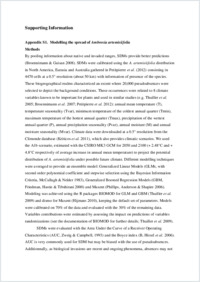Biological Flora of the British Isles: Ambrosia artemisiifolia
- Essl, Franz Department of Botany and Biodiversity Research, Division of Conservation, Vegetation and Landscape Ecology, University of Vienna, Austria - Centre for Invasion Biology, Stellenbosch University, Matieland, South Africa
- Biró, Krisztina Georgikon Faculty, Institute for Plant Protection, University of Pannonia, Keszthely, Hungary
- Brandes, Dietmar Institute for Plant Biology, Technical University Braunschweig, Germany
- Broennimann, Olivier Department of Ecology Evolution, University of Lausanne, Switzerland
- Bullock, James M. NERC Centre for Ecology Hydrology, Wallingford, Oxfordshire, UK
- Chapman, Daniel S. NERC Centre for Ecology Hydrology, Edinburgh, UK
- Chauvel, Bruno INRA, UMR1347, Dijon, France
- Dullinger, Stefan Department of Botany and Biodiversity Research, Division of Conservation, Vegetation and Landscape Ecology, University of Vienna, Austria - Vienna Institute for Nature Conservation Analyses, Vienna, Austria
- Fumanal, Boris Université Blaise Pascal, UMR547 PIAF, BP 10448, Clermont Ferrand, France - INRA, UMR547 PIAF, Clermont Ferrand, France
- Guisan, Antoine Department of Ecology Evolution, University of Lausanne, Switzerland - Institute of Earth Surface Dynamics, University of Lausanne, Switzerland
- Karrer, Gerhard Institute of Botany, University of Natural Resources and Life Sciences Vienna, Austria
- Kazinczi, Gabriella Department of Plant Production and Plant Protection, Institute of Plant Science, Faculty of Agricultural and Environmental Sciences, Kaposvár University, Hungary
- Kueffer, Christoph Institute of Integrative Biology, ETH Zürich, Zürich, Switzerland
- Laitung, Beryl Université de Bourgogne, UMR 1347, Dijon, France
- Lavoie, Claude Ecole supérieure d aménagement du territoire et de développement regional, Université Laval, Québec, Canada
- Leitner, Michael Heinz Maier Leibnitz Zentrum, Technische Universität, München, Garching, Germany
- Mang, Thomas Department of Botany and Biodiversity Research, Division of Conservation, Vegetation and Landscape Ecology, University of Vienna, Austria
- Moser, Dietmar Department of Botany and Biodiversity Research, Division of Conservation, Vegetation and Landscape Ecology, University of Vienna, Austria
- Müller-Schärer, Heinz Department of Biology, Unit Ecology Evolution, University of Fribourg, Switzerland
- Petitpierre, Blaise Department of Ecology Evolution, University of Lausanne, Switzerland
- Richter, Robert Faculty of Physics, University Vienna, Austria
- Schaffner, Urs CABI Switzerland, Delémont, Switzerland
- Smith, Matt Laboratory of Aeropalynology, Faculty of Biology, Adam Mickiewicz University, Pozna , Poland
- Starfinger, Uwe Julius Kuehn Institute, Federal Research Centre for Cultivated Plants, Institute for National and International Plant Health, Braunschweig, Germany
- Vautard, Robert Laboratoire des Sciences du Climat et de l Environnement, Gif sur Yvette, France
- Vogl, Gero Faculty of Physics, University Vienna, Austria
- Lippe, Moritz von der Institute of Ecology, Technical University of Berlin, Germany
- Follak, Swen Austrian Agency for Health and Food Safety, Institute for Sustainable Plant Production, Vienna, Austria
-
01.07.2015
Published in:
- Journal of Ecology. - 2015, vol. 103, no. 4, p. 1069–1098
Agriculture
Biogeography
Climate change
Ecophysiology
Geographical and altitudinal distribution
Germination
Health
Modelling
Parasites and diseases
Reproductive biology
English
This account presents information on all aspects of the biology of Ambrosia artemisiifolia L. (Common ragweed) that are relevant to understanding its ecology. The main topics are presented within the standard framework of the Biological Flora of the British Isles: distribution, habitat, communities, responses to biotic factors, responses to environment, structure and physiology, phenology, floral and seed characters, herbivores and disease, and history, conservation, impacts and management.Ambrosia artemisiifolia is a monoecious, wind-pollinated, annual herb native to North America whose height varies from 10 cm to 2.5 m, according to environmental conditions. It has erect, branched stems and pinnately lobed leaves. Spike-like racemes of male capitula composed of staminate (male) florets terminate the stems, while cyme-like clusters of pistillate (female) florets are arranged in groups in the axils of main and lateral stem leaves.Seeds require prolonged chilling to break dormancy. Following seedling emergence in spring, the rate of vegetative growth depends on temperature, but development occurs over a wide thermal range. In temperate European climates, male and female flowers are produced from summer to early autumn (July to October).Ambrosia artemisiifolia is sensitive to freezing. Late spring frosts kill seedlings and the first autumn frosts terminate the growing season. It has a preference for dry soils of intermediate to rich nutrient level.Ambrosia artemisiifolia was introduced into Europe with seed imports from North America in the 19th century. Since World War II, it has become widespread in temperate regions of Europe and is now abundant in open, disturbed habitats as a ruderal and agricultural weed.Recently, the North American ragweed leaf beetle (Ophraella communa) has been detected in southern Switzerland and northern Italy. This species appears to have the capacity to substantially reduce growth and seed production of A. artemisiifolia.In heavily infested regions of Europe, A. artemisiifolia causes substantial crop-yield losses and its copious, highly allergenic pollen creates considerable public health problems. There is a consensus among models that climate change will allow its northward and uphill spread in Europe.
- Faculty
- Faculté des sciences et de médecine
- Department
- Département de Biologie
- Language
-
- English
- Classification
- Botany
- License
-
License undefined
- Identifiers
-
- RERO DOC 257084
- DOI 10.1111/1365-2745.12424
- Persistent URL
- https://folia.unifr.ch/unifr/documents/304342
Other files
Statistics
Document views: 186
File downloads:
- pdf: 846
- Supplementary material: 145

